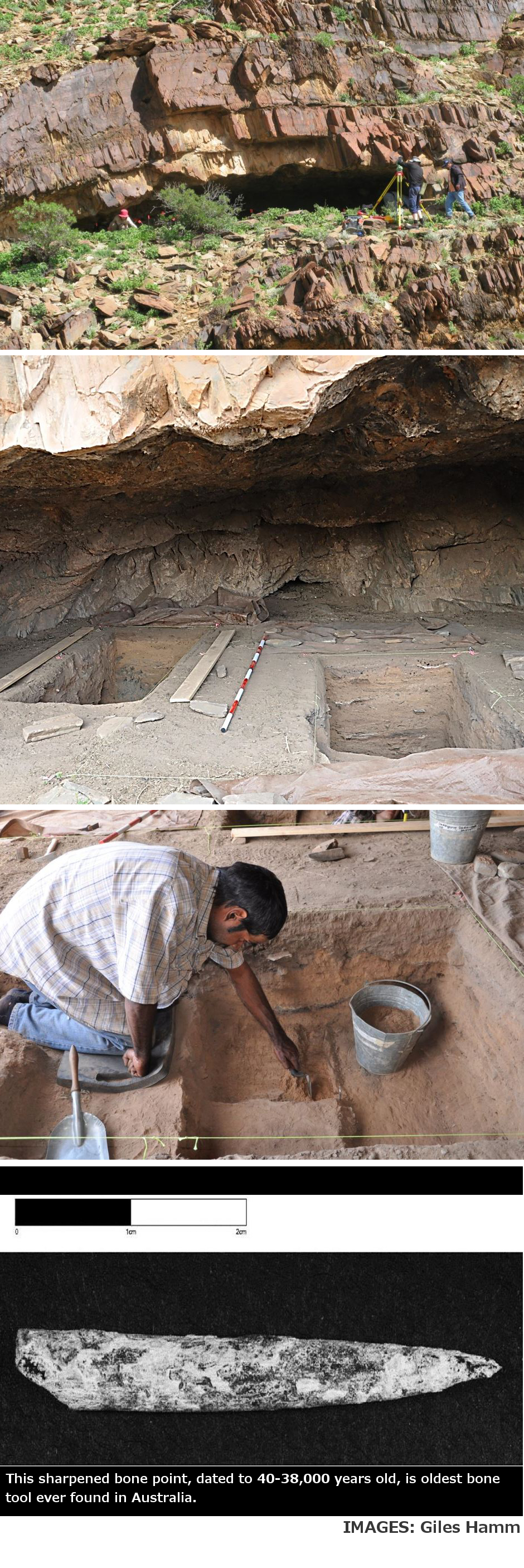SA caves reveal ancient secrets
 A new study pushes back the history of Aboriginal invention by 10,000 years, and reveals their interactions with the ancient beasts that used to inhabit Australia.
A new study pushes back the history of Aboriginal invention by 10,000 years, and reveals their interactions with the ancient beasts that used to inhabit Australia.
The result of a nine-year long research program shows that humans occupied Australia’s arid interior and began developing sophisticated tools around 49,000 years ago, about 10,000 years earlier than previously documented.
The findings from the Warratyi Rock Shelter in the desert region of northern South Australia, show it to contain the oldest evidence of Aboriginal occupation in the arid area of South Australia.
Bones of the extinct giant wombat-like creature, Diprotodon optatum, and eggs from an ancient giant bird were also found in the cave, suggesting humans were also interacting with the local megafauna.
Humans arrived in Australia about 50,000 years ago. However, the timing of both their settlement of the continent’s arid interior and the development of technologically-innovative material culture (such as advanced stone tools), along with the degree to which they interacted with now-extinct giant animals (megafauna), are still debated within the scientific community.
Researchers analysed material discovered during an excavation at Warratyi rock shelter in the Flinders Ranges, finding that humans occupied the site from 49,000 to 46,000 years ago.
Objects recovered from the various layers of sediment represent the earliest-known use in Australia of various notable technologies. These include worked bone tools (40,000–38,000 years ago), backed stone tools (30,000–24,000 years ago), and the use as pigments of red ochre (49,000–46,000 years ago) and gypsum (40,000–33,000 years ago).
The study also describes evidence of human co-existence with Diprotodon optatum, the largest-known marsupial, and the giant bird Genyornis newtoni. The authors note this discovery is the only reliably dated, well-stratified record of extinct Australian megafauna associated with artefacts older than 46,000 years, and the clearest evidence yet for their interaction with humans.
The academics worked closely with members of the Adnyamathanha Traditional Lands Association for almost a decade on the survey of the cave.
Adnyamathanha man Clifford Coulthard worked on the property where Warratyi was located when he was a teenager, and said elders at the time had shared stories of their people living in the area, including in the shelters.
Mr Coulthard said he had forgotten some of the information until he joined the researchers, saying “the spirits showed me the road” to the site.
He said the Adnyamathanha people were proud and happy about the discovery, and to have their history brought to light.
University of Adelaide researchers – Dr Lee Arnold, Adjunct Professor Nigel Spooner and Ms Daniele Questiaux – undertook the geo-chronological aspects of the study.
“One of the key strengths of this study is the chronology, which has typically proved to be a contentious issue at early archaeological sites in Australia,” says Dr Arnold.
“We have used a range of complementary dating techniques and targeted different types of materials to ensure that the age of the site is reliably known.”
The team applied a novel sediment dating technique known as single-grain optically stimulated luminescence (OSL) dating to determine when the fossil and artefact bearing sediments were deposited. Combined with statistical techniques, they were able to determine a precise occupation history for the archaeological site.
“The Warratyi Rock Shelter is a remarkable discovery, showing aboriginal settlement of the Australian arid zone long before the last ice age and contemporaneous with iconic Australian megafauna, and revealing an innovative material culture, including the utilisation of ochre pigments, much earlier than previously recorded for Australia and Southeast Asia,” Professor Spooner said.







 Print
Print